
Asclepias tuberosa, commonly known as butterfly weed, is a species of milkweed native to eastern and southwestern North America. It is commonly known as butterfly weed because of the butterflies that are attracted to the plant by its color and its copious production of nectar.

Leucanthemum vulgare, commonly known as the ox-eye daisy, oxeye daisy, dog daisy, marguerite and other common names, is a widespread flowering plant native to Europe and the temperate regions of Asia, and an introduced plant to North America, Australia and New Zealand.

Dryas is a genus of perennial cushion-forming evergreen dwarf shrubs in the family Rosaceae, native to the arctic and alpine regions of Europe, Asia and North America. The genus is named after the dryads, the tree nymphs of ancient Greek mythology. The classification of Dryas within the Rosaceae has been unclear. The genus was formerly placed in the subfamily Rosoideae, but is now placed in subfamily Dryadoideae.

Saxifraga is the largest genus in the family Saxifragaceae, containing about 473 species of holarctic perennial plants, known as saxifrages or rockfoils. The Latin word saxifraga means literally "stone-breaker", from Latin saxum + frangere. It is usually thought to indicate a medicinal use for treatment of urinary calculi, rather than breaking rocks apart.
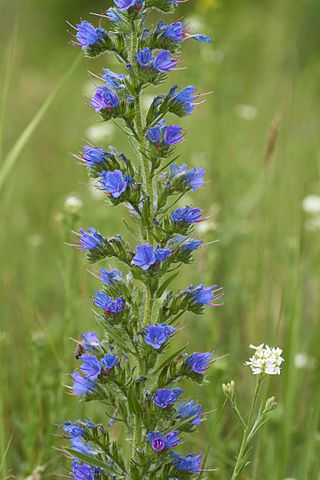
Echium vulgare, known as viper's bugloss and blueweed, is a species of flowering plant in the borage family Boraginaceae. It is native to most of Europe and western and central Asia and it occurs as an introduced species in north-eastern North America, south-western South America and the South and North Island of New Zealand. The plant root was used in ancient times as a treatment for snake or viper bites. If eaten, the plant is toxic to horses and cattle through the accumulation of pyrrolizidine alkaloids in the liver.
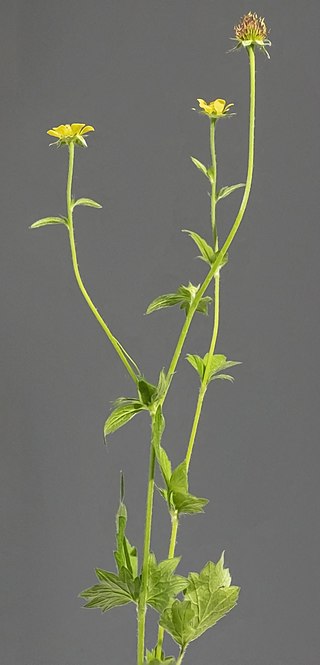
Geum urbanum, also known as wood avens, herb Bennet, colewort and St. Benedict's herb, is a perennial plant in the rose family (Rosaceae), which grows in shady places in the temperate regions of Eurasia and North America.
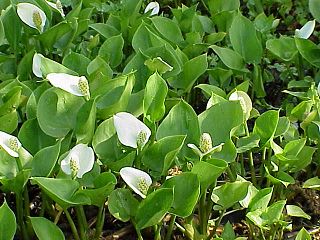
Calla is a genus of flowering plant in the family Araceae, containing the single species Calla palustris.

Linaria vulgaris, the common toadflax, yellow toadflax or butter-and-eggs, is a species of flowering plant in the family Plantaginaceae, native to Europe, Siberia and Central Asia. It has also been introduced and is now common in North America.

Geum aleppicum, commonly called yellow avens or common avens is a flowering plant native to most of the temperate Northern Hemisphere, from eastern Europe across Asia and North America.
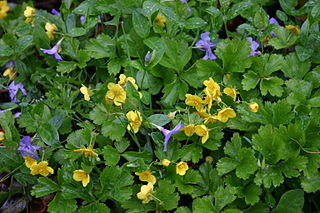
Waldsteinia fragarioides (syn. Dalibarda fragarioides Michx. and Geum fragarioides, also called Appalachian barren strawberry, or just barren strawberry, is a low, spreading plant with showy yellow flowers that appear in early spring. This plant is often used as an underplanting in perennial gardens.
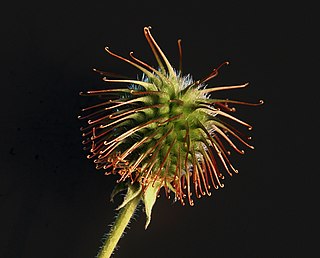
A bur is a seed or dry fruit or infructescence that has hooks or teeth. The main function of the bur is to spread the seeds of the bur plant, often through epizoochory. The hooks of the bur are used to latch onto fur or fabric, enabling the bur – which contain seeds – to be transported to another location for dispersal. Another use for the spines and hooks are physical protection against herbivores. Their ability to stick to animals and fabrics has shaped their reputation as bothersome.

Symphyotrichum ericoides, with common names white heath aster, frost aster, and heath aster, is a species of flowering plant in the family Asteraceae native to much of central and eastern North America. It has been introduced to parts of Europe and western Asia.

Geum quellyon, commonly called scarlet avens, Chilean avens, Double Bloody Mary, or Grecian rose, is a perennial herb in the family Rosaceae. It is native to the central and southern regions of Chile. G. quellyon has been introduced to other countries including Belgium, Bolivia, and the United Kingdom, where it was first planted in 1826.

Geum triflorum, commonly known as prairie smoke, old man's whiskers, or three-flowered avens, is a spring-blooming perennial herbaceous plant of the Rosaceae family. It is a hemiboreal continental climate species that is widespread in colder and drier environments of western North America, although it does occur in isolated populations as far east as New York and Ontario. It is particularly known for the long feathery plumes on the seed heads that have inspired many of the regional common names and aid in wind dispersal of its seeds.
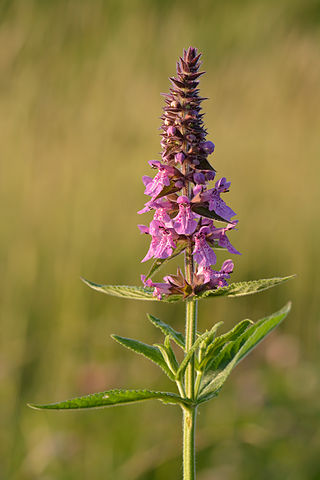
Stachys palustris, commonly known as marsh woundwort, marsh betony, clown's woundwort, clown's heal-all, marsh hedgenettle, or hedge-nettle, is an edible perennial grassland herb growing to 80 centimeters tall. It is native to parts of Eurasia but has been introduced to North America. The species epithet palustris is Latin for "of the marsh" and indicates its common habitat.
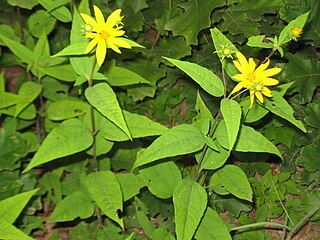
Helianthus divaricatus, commonly known as the rough sunflower, woodland sunflower, or rough woodland sunflower, is a North American species perennial herb in the family Asteraceae. It is native to central and eastern North America, from Ontario and Quebec in the north, south to Florida and Louisiana and west to Oklahoma and Iowa.

Geum rossii is a species of flowering plant in the rose family known by the common names Ross' avens and alpine avens. It is native to North America where its distribution spans northern Canada and the high mountains of the western United States. It grows at high-latitude and high-elevation habitat, including the Arctic and in alpine climates. There are three varieties. One, var. depressum, is endemic to Washington in the United States, where it is limited to the Wenatchee Mountains.
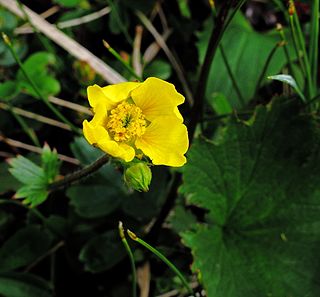
Geum peckii is a species of herbaceous, perennial flowering plant in the rose family known by the common name mountain avens. It is native to eastern North America, where it is known from only two locations, the White Mountains of New Hampshire and three sites in Nova Scotia.

Symphyotrichum lanceolatum is a species of flowering plant in the family Asteraceae native to North America. Common names include panicled aster, lance-leaved aster, and white panicled aster. It is a perennial, herbaceous plant that may reach 1.5 meters tall or more, sometimes approaching 2 m. The lance-shaped leaves are generally hairless but may feel slightly rough to the touch on the top because of tiny bristles. S. lanceolatum blooms July to October. The flowers grow in clusters and branch in panicles. They have 16–50 white ray florets that are up to 14 millimeters long and sometimes tinged pink or purple. The flower centers consist of disk florets that begin as yellow and become purple as they mature.
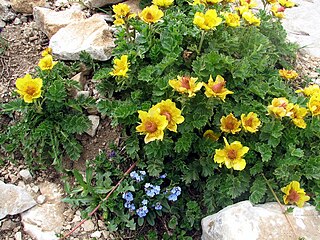
Geum reptans, the creeping avens, is a species of flowering plant in the genus Geum of the family Rosaceae native to some mountains of Central and Southeastern Europe. A long-lived perennial that reproduces both sexually and clonally, it has high phenotypic variation, but these variable traits do not appear to be adaptations to local conditions.























